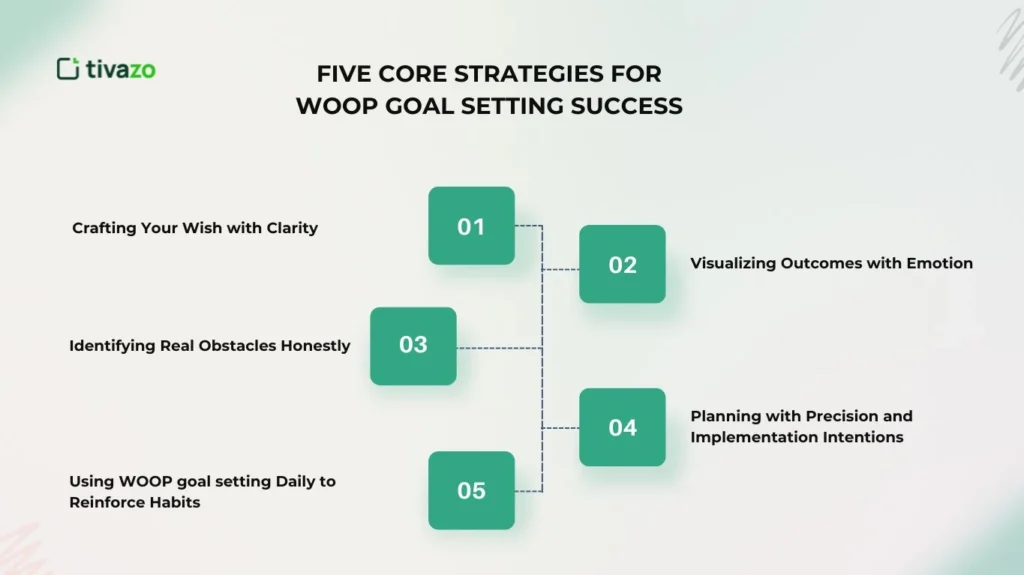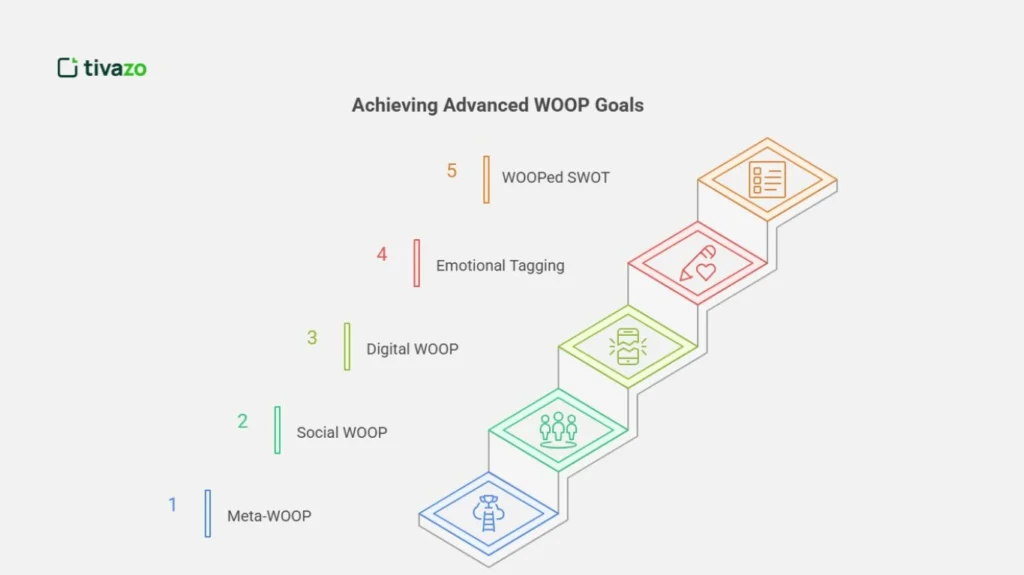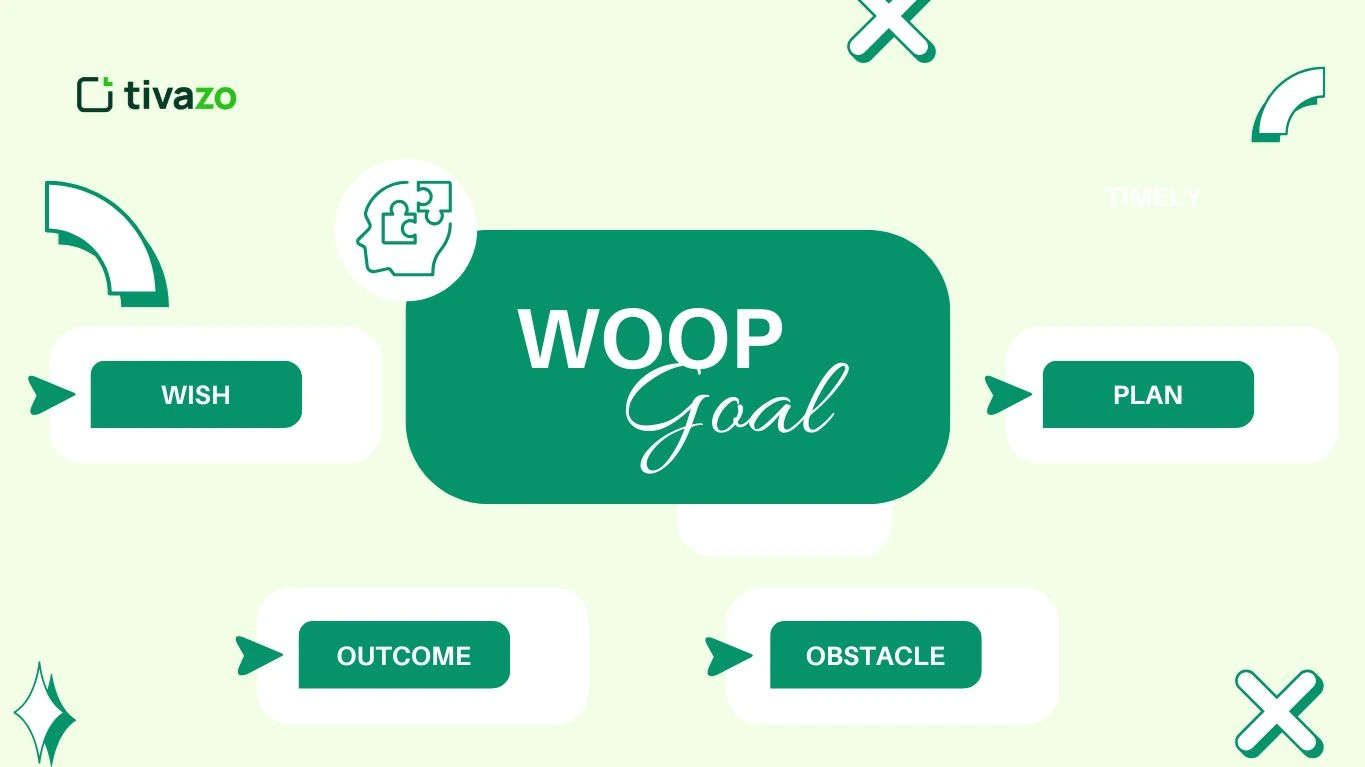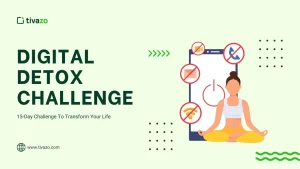You’ve set big goals – such as getting promoted, passing your exams, or starting to meditate daily – only to watch them disappear by mid-way through the year. WOOP goal setting is a scientifically supported alternative: a simple four-step process of weaving your best wishes, with the reality of honest assessments, plus tangible, actionable insights. You can close your eyes and imagine achieving success, face the obstacle that would keep you from accomplishing it, and then devise a decision-making “If… then…” plan to help you overcome it.
Created by psychologist Dr. Gabriele Oettingen, WOOP has taken wishes to accomplishment, increasing follow-through by up to 42%. In this guide, you will review five evidence-based strategies with real-world examples and examples of actionable approaches to develop not only clear, achievable goal-setting but also stay encouraged/reinforced until you reach the finish line.
Key Highlights:
- What Is the WOOP Method for Goals
- Five Core Strategies for WOOP Goal Setting Success
- WOOP Goal Setting for Career Transitions
- Integrating WOOP Goal Setting with Other Frameworks
- Advanced WOOP Goal Setting Techniques
- Common Mistakes to Avoid in woop
What Is the WOOP Method for Goals?
WOOP is an acronym for Wish, Outcome, Obstacle, Plan—a science-based, four-step mental strategy for working with people to set and achieve meaningful goals by ensuring the integration of motivation and practical planning.
Here’s a quick breakdown:
- Wish: Define a meaningful, relevant goal that you can achieve.
- Outcome: Picture the best outcome possible if that wish becomes reality.
- Obstacle: Acknowledge honestly anything inside of you that may stop you from succeeding.
- Plan: Construct an action plan based on “If ___, then ___” to overcome the obstacle.
How to Set Goals on WOOP?
Before you begin the process in the working steps of WOOP, it’s important to realize that WOOP goal setting is more than just a task list; it is a shift in mindset. By intentionally choosing one area of focus, you provide your brain with permission to concentrate its efforts, leaving out distractions and increasing motivation.
Each step from wish to outcome, to obstacle, to plan aims to generate momentum, founded on clarity, emotion, and pre-commitment. You can think of the process in terms of plotting a destination; first you choose where you want to get to, then you imagine what vista you will be celebrating when you finish the journey, then you frankly face the mountains ahead of you, then finally, you plot the actual bridges you are going to cross. Regular reviews allow for your WOOP to mesh with changes in your life, ensuring you stay on track, whatever happens.
- Choose One Focus Area: Career, health, learning, etc. Pick your number one priority.
- Write Your Wish: Clear, present tense, desired outcome (e.g., “I excel at public speaking”).
- Describe the Best Outcome: What success looks and feels like.
- Identify the Main Obstacle: Pinpoint the one thing likely to derail you.
- Formulate Your Plan: Use the implementation intentions technique to pre‑commit responses.
Why WOOP Works
WOOP goal setting is distinctive because it combines wishful thinking with an honest evaluation of reality. WOOP (Wish, Outcome, Obstacle, Plan) is the creation of Dr. Gabriele Oettingen, who has applied mental contrasting and implementation intentions to help goal/setters turn desires into outcomes.
- Mental Contrasting: You will vividly picture your desired outcome and then pit that image against the real-world obstacles in your way.
- Implementation Intentions: You proactively and voluntarily pre-commit yourself: “If obstacle X occurs, then I will do action Y”.
By affecting both your conscious and unconscious mind, you can improve your follow-through rate by 42% on average Oettingen, 2014. Unlike SMART goals or OKRs, which only focus on clarity or metrics, WOOP goal setting links desire and discipline.
Five Core Strategies for WOOP Goal Setting Success
The five Core Strategies for WOOP Goal Setting Success are:

Strategy 1: Crafting Your Wish with Clarity
In any powerful WOOP goal-setting exercise, a wish that is clearly defined is the beginning of success. For example, instead of a vague intention like “get better at sales,” define your wish as “increase monthly sales by 15% within three months.” This level of specificity gives you a great goal instead of just a wish, which increases motivation and lights up your brain’s reward systems on a pathway to every achievement.
Finding the right phrasing of different variations until you arrive at something that feels both challenging and reasonably realistic begins the process of follow-through because clarity promotes confidence, and confidence promotes action. Spend a moment to write out a few different versions of your wish, and then choose the one that sparks the most inner motivation. This clarity-check ceremony becomes your first habit that actively propels your WOOP goal setting!
Strategy 2: Visualizing Outcomes with Emotion
Visualization seems like just daydreaming, but daydreaming is also the secret ingredient employed by all high performers. Take just two minutes without interruption to vividly visualize the specifics of your desired outcome: the faces of those in the audience, the sounds of applause, the scent of freshly printed stationery when you sign that new contract.
Studies show that sensory-rich visualization can increase goal commitment by up to 31%, as vividly imagined outcomes are processed by the brain as if they were real. It’s like when you add this emotional component in your WOOP goal setting, you are not simply hoping you will be great—you are already living in your mind’s mindset.
To enhance this idea, try making a short voice memo of your imagined scenario and replay this before every new WOOP session. Think of this creative process as a warm-up to help you focus and fire up your mind mentally.
Strategy 3: Identifying Real Obstacles Honestly
The most difficult obstacle when goal setting with WOOP is not the dreaming part—it’s facing the real obstacles that are blocking your way. Schedule time for yourself to write out your main internal and external obstacles while being as honest as possible. Procrastination can sometimes show up as “I get distracted by my phone,” and self-doubt can sound like “What if I am not good enough.”
There is no way to deal with challenges to their roots without naming and getting completely clear on them. Ugly honesty in emotional reflection using mental contrasting with implementation intentions means that your next implementation intention won’t crawl forward without recognizing harsh realities, as showing you what is real going forward, so that you can be resilient.
Have a trusted friend or mentor review your obstacle list— this can also help illuminate things that you otherwise, in blind opportunity costs, may have completely overlooked. Being honest collectively embeds accountability in all of your commitments. This will help to remove the feeling of burnout
Strategy 4: Planning with Precision and Implementation Intentions
A wish that is not associated with a plan will be just that: a wish; however, WOOP goal setting smooths that path with the simply elegant “If [Obstacle], then I will [Action]” model. Once you have identified your obstacles, you will create an associated “If…then…” statement for each one. For example, the student who is struggling in calculus changed “I feel overwhelmed after lectures” to “If I feel overwhelmed, then I will do 30 minutes of practice problems right after.”
This simple change assists in automating your response, thinking is eliminated, and you just turn it over to your commitment to your plan. These small commitments, compounded over time, lead you closer to your desired outcome. Write every “If…then…” plan onto a sticky note and place the note where you will see it at the moment of execution—perhaps on your desk, on your mirror, or beside your yoga mat. This is not only an incentive reminder of the plans you made, but a cognitive development to reinforce the neural pathway between the obstacle and the action.
Strategy 5: Using WOOP goal setting Daily to Reinforce Habits
The real power of WOOP goal setting is the act of repetition. When you incorporate a two‑minute WOOP check-in into your morning routine, right before you have coffee or meditate, you will have developed a habit that will set the tone for your day. Keep track of each session and celebrate small accomplishments using available tools or apps like WOOP My Life.
When you pair WOOP goal-setting practice with existing rituals, it moves from a conscious activity to an automatic activity, or mindset, that will quietly and repeatedly re-align your actions with your deepest wishes each day. Along with your daily check-in, journal just a couple of sentences of reflection: what worked, what didn’t, and any surprises.
The reflection component not only provides you with a way to measure your progress but also serves to refresh your motivation by providing a snapshot of how far you have come.
What is the WOOP goal-setting Coaching Model?
WOOP coaching is the development of a solo mindset tool into a conversation that enables collaboration and transformation of the individual coachee and coach. In effect, it’s not a model, more like a guided conversation between the coach and the athlete. The comprehensive process begins in Discovery, where they do a lot of reflection on important wishes using goal visualisation techniques that allow the individuals to vividly picture a desired outcome that holds meaning for them.
In the Contrast phase, they look at their wishes – in an honest way – by having them identify their internal blocks and environmental triggers, surfacing what might get in the way of progress. In the Design phase, they are developing super-specific “If, then” implementation intentions that are anchored to the desired rhythm of the coachee.
Subsequently, the Deploy phase is where the intentions come alive in the daily practice of the coachee and where the coach provides support and is able to hold intentional accountability, and assist with course corrections when necessary. Finally, the Debrief phase helps the individuals surface their results, refine their strategy, and congratulate themselves on their momentum.
The five-phase presentation – Discovery, Contrast, Design, Deploy, Debrief – improves the chances of success in WOOP goal setting, while also positively impacting trust, clarifying agreement, and fostering sustainability in development.
WOOP Goal Setting for Career Transitions
Changing careers can sometimes feel like you’re entering a new and unknown world, but WOOP goal setting can give a clarity and boost your confidence with a roadmap. Start by identifying your true aspiration – your Wish – for example, “Start my freelance consultancy.”Next, look at your reality, and understand what the obstacle is to that, like “I don’t have client referrals.” Now that you have been honest about the reality, create clear “If Obstacle then Action” plans, for example, “If I’m struggling to find leads, then I’ll reach out for LinkedIn contacts every Monday.”
You can also let the wind behind you sail faster by including professional tips: join LinkedIn Learning, take a class that will grow the skills you can market, schedule your weekly outcome visualizations to keep your desire clear and tangible, and have micro-steps in your transition that you will check off daily. By linking your freelance wish with WOOP’s psychological mental-contrasting and supportive habits and hacks, you will turn what seems like a change in your career into a series of positive, easily accessible wins.
Integrating WOOP Goal Setting with Other Frameworks
SMART + WOOP: Structure Meets Motivation
Frame your Wish as a SMART goal (e.g., “Reduce email response time to two hours or less for all direct reports by the end of the quarter”). Then move into WOOP mode and visualize your success, name your obstacle (e.g., “team is overloaded”), and plan to address it (e.g., “If I don’t hear a reply in two hours, then I will send them a Slack reminder”). When you combine the structures of SMART with the motivation of WOOP, you get clarity with follow‑through.
WOOP & OKRs: Personal Goals Aligned with Team Wins
Find your WOOP Wish in your team’s OKR (e.g., “Increase retention by fifteen percent” and “Improve onboarding satisfaction to 90%”). Name the obstacles (e.g., “new hires felt overwhelmed”) and the plan (e.g., “If I see confusion, then I will break down training into micro‑modules.”). Now your progress becomes connected to organizational outcomes.
Hybrid Reviews: WOOP Goal Setting Check‑Ins Mid‑OKR Cycle
At the six-week point of every quarter, take the time to pause for a quick WOOP check-in. Revisit your Wish, identify new Obstacles, and adjust your “If X then Y” plans. These mid‑cycle check-ins give you the agility to adapt in the moment rather than wait until a quarterly review to see if you succeeded.
Advanced WOOP Goal Setting Techniques
Advanced WOOP Goal Setting Techniques are

- Meta‑WOOP for Cascading Goals
Create a hierarchy of WOOPs: at the top is a big possibility Wish (e.g., “I will scale my business by 2× in the coming year.”), and then tailored sub-WOOPs weekly or monthly, easing into that wish possibility. This hierarchy will keep your daily actions relevant to the lofty goals or wishes you may have. - Social WOOP Accountability
Make use of your social connections, or find a small group of peers, and do some “WOOP goal setting Circles.” Share your Wishes, Obstacles, and Plans in a couple of short Zoom calls weekly. The commitment to sharing with either a peer (for personal development) or a small community (to develop a habit) will exponentially elevate your accountability and provide other insights on how to engage in deep work as you move past known or anticipated obstacles. - Digital WOOP with Smart Reminders
Insert your “If X then Y” possibilities into alerts in your calendar, Slack BOT, or habit application. If you miss a workout or hit an obstacle, your mental trigger kicks in, reminding you of your pre-committed plan and guiding you to act automatically. - Emotional Tagging & Journaling
Review your emotional intensity and write a single one-sentence insight (e.g., “I feel invigorated by this Wish,” etc.) at the end of each WOOP experience. Over time, you will observe which wishes and Plans trigger your excitement most, allowing you to use this information to satisfy the motivational hook for the following WOOPs. - WOOPed SWOT Analysis
Integrate WOOP with a mini-SWOT (Strengths, Weaknesses, Opportunities, Threats) analysis for complex projects. Use the Obstacle phase of WOOP to identify Weaknesses/Threats, and the Outcome phase of WOOP goal setting to identify Strengths/Opportunities, then implement a plan accordingly.
Tools & Apps to Enhance Your WOOP Goal Setting Practice
- WOOP My Life: The official WOOP app, created by Gabriele Oettingen’s team, takes you through the WOOP process—Wish, Outcome, Obstacle, and Plan—with easy-to-follow prompts. The app can be used to develop daily goals or work out long-term transitions, and it helps you keep track of goals in a structured way, while keeping goals and progress top of mind. There are even reminders to make WOOP a habit of practice and not a one-off event.
- Notion and Asana Templates: If you’re already using Notion or Asana in order to be more productive, introducing WOOP goal setting to your framework is really simple. You can map out your goals with pre-made templates, including a SMART Wish, outcomes, and obstacles using collapsible toggles, and tracking your “If-Then..” plan using checklists or task boards. This is perfect for professionals who want WOOP easily integrated into their digital workflows and remain as consistent as possible.
- Paper Journals and Planners: If paper is your preference for thinking, then a WOOP goal-setting worksheet offers an alternative style of tactile, mindful, and paper-based goal-setting. Whether it is a printed worksheet or a bespoke planner, pen on paper in itself slows you down just enough to contemplate your thoughts more deeply. Many high-performers wrap to analog writing to clarify goals, direct focus, and connect emotionally.
Common Mistakes to Avoid
Common Mistakes are as follows:

- Treating WOOP Like a One-Time Exercise
WOOP is not a tick box – it is a mindset ritual. One of the biggest pitfalls we see people fall into is completing WOOP goal setting once during a workshop or coaching session, then forgetting it altogether. To realize the real outputs of WOOP, you must practice it repeatedly, ideally regularly (every day or weekly in your planning time). The more you continue to HOOP (over and over), the sharper and committed you become.
- Being Too Vague with Your Wish
“Pursue health” or “be more productive” is not going to cut it. A Wish needs to be thoughtfully specific, motivating, and actionable. For example, “Lose 10 lbs in 8 weeks through meal prep and 30-minute walks, 6 days per week” gives your brain a clear target and plan for your body. The more specific you can be with your wish, the more juice you will have to follow through.
- Being Too Vague with Your Wish
“Pursue health” or “be more productive” is not going to cut it. A Wish needs to be thoughtfully specific, motivating, and actionable. For example, “Lose 10 lbs in 8 weeks through meal prep and 30-minute walks, 6 days per week” gives your brain a clear target and plan for your body. The more specific you can be with your wish, the more juice you will have to follow through.
Conclusion
WOOP goal setting is not simply another goal-setting framework – it is a mindset for transformation. When you combine your greatest wish or idea with a transparent analysis of obstacles and implementation intentions, you create a map that the brain and your motivation would find it difficult to neglect. Use these five effective approaches, utilize advanced approaches, and use apps and other tools to strengthen new habits. Trying a new occupation or career, achieving exceptional grades, or optimizing team performance are all possibilities where WOOP provides the scope, flexibility, and science needed.
Feeling ready to get started? If you haven’t already, download the free WOOP Goal Setting Worksheet and take the first step to realizing your biggest wishes and ideas into success.
FAQs
What are the 5 F’s of goal setting?
The 5 F’s are Focus, Feedback, Flexibility, Feasibility, and Follow-through—key traits that help keep goals achievable and actionable.
How to set goals on WOOP?
Start by choosing a wish, imagining the best outcome, identifying your main obstacle, and crafting an “If… then…” plan to overcome it. Practice daily.
How is WOOP different from SMART goals?
SMART focuses on structuring goals (Specific, Measurable, etc.), while WOOP adds emotional motivation and pre-commitment planning to tackle real-world obstacles.
Can WOOP goal setting improve productivity and motivation?
Yes. Studies show WOOP increases goal follow-through by up to 42% by aligning intention with emotional clarity and concrete action steps.
Who should use WOOP?
WOOP is ideal for students, professionals, athletes, coaches, and teams—anyone who wants to set meaningful goals and stick to them realistically.




